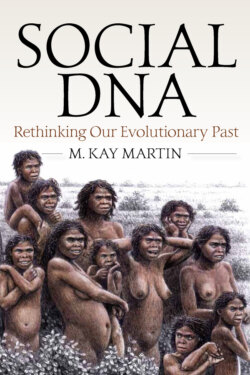Читать книгу Social DNA - M. Kay Martin - Страница 21
На сайте Литреса книга снята с продажи.
Exploitation and Parasitism
ОглавлениеPerhaps the most well-known work linking anisogamy to male social dominance is Dawkins’s The Selfish Gene (1976). It advances the notion that genes tailor their replication strategies to fit the bodies in which they find themselves and that these opportunities differ for male and female bodies. For Dawkins, it all comes down to anisogamy—all social differences between the sexes can be traced to the fact that sperm cells are smaller and more numerous than eggs:
Sperms and eggs . . . contribute equal numbers of genes, but eggs contribute far more in the way of food reserves: indeed, sperms make no contribution at all and are simply concerned with transporting their genes as fast as possible to an egg. At the moment of conception, therefore, the father has invested less than his fair share (i.e. 50 percent) of resources in the offspring. Since each sperm is so tiny, a male can afford to make many millions of them every day. This means that he is potentially able to beget a very large number of children in a very short period of time, using different females. This therefore places a limit on the number of children a female can have, but the number of children a male can have is virtually unlimited. Female exploitation begins here. (Dawkins 1976: 141–42, emphasis added)
The theory is that each reproductive partner has the goal of maximizing the number of their surviving offspring, but that females are at a disadvantage due to their greater parental investment. According to Dawkins, two principal “counter-ploys” may be pursued by females to reduce their exploitation by males. The first, dubbed the “domestic-bliss” strategy, envisions females as feigning “coyness” in order to assess potential mates in advance for favorable attributes (i.e., fidelity and domestic assistance) and to demand material investments prior to copulation. The second is referred to as the “he-man” strategy, where females, in lieu of securing parental assistance for their offspring, settle for trying to select mates that appear to have “good genes.”
These strategies notwithstanding, Dawkins’s scheme offers females little hope for escape from exploitation by promiscuous males, who are portrayed as naturally self-serving, devious, and irresponsible. Saddled as such with their “egg yokes,” females are equipped with few liberating tools beyond withholding sexual favors, clandestine entrapment of reluctant progenitors, or luck of the draw.
Figure 1.1. Selfish-gene theory and the origin of female exploitation. By Drew Fagan.
Dawkins’s selfish-gene hypothesis is taken to its logical extreme by van den Berghe (1979), who adopts it as a template for understanding the structure of human social groups, past and present. He proposes that coyness and slower erotic arousal have evolved as female strategies to counter male seduction and to ensnare men into monogamous or pair-bonded relationships. Males, in contrast, are naturally promiscuous, and seek to parasitize women for their reproductive potential. Male dominance, patrilineal descent groups, and polygyny are seen as natural outcomes of the desire of men to secure the reproductive power of women, assure paternity, increase the number of offspring, and maximize their inclusive fitness by passing property on to their sons. Matrilineal social groups, while recognized, are viewed as rare and aberrant, arising where paternity is made less certain by a high incidence of adultery, divorce, and the “cuckolding” of absentee males. In these situations, it is argued, parasitism by males is simply transferred to their brothers-in-law for the benefit of their uterine nephews, with whom they share genes through their sisters. According to van den Berghe (1979: 108): “In both types of society, women are dominated by men who set norms in an attempt to control women’s reproductive behavior for maximum male fitness.”
The picture that emerges from such selfish-gene models, then, is that anisogamy has preprogrammed the sexes for asymmetrical and parasitic reproductive roles in the evolutionary drama. Males are typecast as the sexual protagonists and females as the reticent objects of their exploitation. Similar conclusions on the proclivities and copulatory appetites of the sexes were reached by Daly and Wilson (1978) and by Symons (1979).7
Such theories generated immediate controversy and academic debate within the field of evolutionary biology. Is our species the product of a grand genomic zero-sum game? Were the selective pressures that favored cooperative behaviors and encephalization in evolving hominins exerted largely on males? Are female primates naturally passive, noncompetitive, and asexual? Continuing research over the ensuing decades has shed new light on these questions, and has challenged previous notions about both human sexuality and human societal origins.
